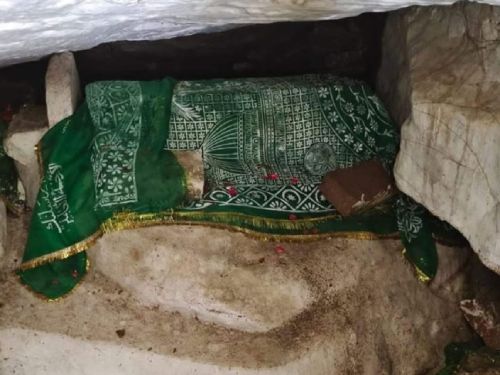
A fresh example of Land Jihad has emerged in Bihar, where a historical site, an Ashoka edict has been converted into a Mazar over time. More than 2300-year-old Ashoka edict has been made into a Mazar, and prayers are being offered at the site after it has been covered with a green cloth.
Ashoka the Great embossed the edict 2300 years ago in the natural cavern of Chandan Hill of the Kaimur hill range at Sasaram, the headquarters of Bihar’s Rohtas district. This inscription is in Brahmi script, and it is one of just eight in the country. This inscription is listed among them, and it is the sole inscription from Bihar.
The inscription has been encircled by unlawful construction around it. The inscription has been made a Mazar now by covering it with a green cloth after it had been coated with white lime. An annual Urs is also being organised there by declaring it as the tomb of a Sufi saint. The gate of the monument is kept closed following this illegal construction.
जिहादियों का "लैंड जिहाद"
बिहार के सासाराम में सम्राट अशोक के शिलालेख पर बना दी मजार
जिहादियों ने भगवान बुध के शांति के संदेशों को भी नही बक्शा
अभी अगर ये हाल है तो सोचिए अगर इन जिहादियों की संख्या बढ़ी तो आगे पाकिस्तान जैसे हालात हिंदू के लिए यहाँ बन जायेगा pic.twitter.com/hBcsGjjV3W— ALOK JHA (@STVAlok) September 26, 2022
In the years following independence, the Archaeological Survey of India (ASI) designated this edict as a protected monument in 2008. The ASI had also put up a conservation board near the inscription at Kandara, which is located about 20 feet below the top of the Ashiqpur hill in the Kaimur hill range between Sasaram city’s old Grand Trunk Road (GT Road) and the new bypass. However, the encroachers removed the board.
In 2008, 2012, and 2018, the ASI ordered that the encroachments surrounding the Ashoka edict be removed by the District Magistrate (DM). Following this, the District Magistrate directed the SDM of Sasaram to take appropriate action. The SDM had ordered the Markazi Muharram Committee, which had illegally encroached on the site, to immediately hand over the key to the administration, but the committee refused. A large structure was gradually constructed illegally there.
During the British Raj, this inscription was rediscovered in 1917. The Archaeological Survey of India (ASI) has addressed over 20 letters to the district administration requesting that the status quo on this site be maintained, however, attempts are being made to obliterate the trace of this monument.

Emperor Ashoka carved this edict in eight locations around the nation in 256 BC. One of them is on Sasaram’s Chandan hill. Ashoka had these inscriptions engraved in various locations to promote the teachings of Buddhism. Brahmi was the people’s language at the time and as a result, these messages were written in that language.
A similar incident recently occurred in Maharashtra, where Shivaji Maharaj’s ‘Lohagarh’ fort was unlawfully encroached and proclaimed to be the grave of an alleged Sufi saint named ‘Umar Shahawali Baba.’ Following that, the annual Urs (fair) was also held there.
Historians argue that there was no tomb or mosque there even during the reign of Chhatrapati Shahuji Maharaj. It was later formed as a result of unlawful occupancy. It is not, however, restricted to Sasaram and Lohagarh Fort. Such tombs can be seen from Ajmer fort to all the forts in the country and places of historic Hindu heritage. Locals claim that attempts are being made to seize such structures by illegally encroaching on them.
Source: OpIndia





